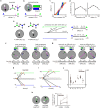Decision heuristics in contexts integrating action selection and execution
- PMID: 37081031
- PMCID: PMC10119283
- DOI: 10.1038/s41598-023-33008-2
Decision heuristics in contexts integrating action selection and execution
Abstract
Heuristics can inform human decision making in complex environments through a reduction of computational requirements (accuracy-resource trade-off) and a robustness to overparameterisation (less-is-more). However, tasks capturing the efficiency of heuristics typically ignore action proficiency in determining rewards. The requisite movement parameterisation in sensorimotor control questions whether heuristics preserve efficiency when actions are nontrivial. We developed a novel action selection-execution task requiring joint optimisation of action selection and spatio-temporal skillful execution. State-appropriate choices could be determined by a simple spatial heuristic, or by more complex planning. Computational models of action selection parsimoniously distinguished human participants who adopted the heuristic from those using a more complex planning strategy. Broader comparative analyses then revealed that participants using the heuristic showed combined decisional (selection) and skill (execution) advantages, consistent with a less-is-more framework. In addition, the skill advantage of the heuristic group was predominantly in the core spatial features that also shaped their decision policy, evidence that the dimensions of information guiding action selection might be yoked to salient features in skill learning.
© 2023. The Author(s).
Conflict of interest statement
The authors declare no competing interests.
Figures



Similar articles
-
Heuristics contribute to sensorimotor decision-making under risk.Psychon Bull Rev. 2022 Feb;29(1):145-158. doi: 10.3758/s13423-021-01986-x. Epub 2021 Sep 10. Psychon Bull Rev. 2022. PMID: 34508307
-
Heuristic pruning of decision trees at low probabilities and probability discounting in sequential planning in young and older adults.Sci Rep. 2025 May 9;15(1):16260. doi: 10.1038/s41598-025-00905-7. Sci Rep. 2025. PMID: 40346145 Free PMC article.
-
Strategy selection as rational metareasoning.Psychol Rev. 2017 Nov;124(6):762-794. doi: 10.1037/rev0000075. Psychol Rev. 2017. PMID: 29106268
-
Heuristic decision making in medicine.Dialogues Clin Neurosci. 2012 Mar;14(1):77-89. doi: 10.31887/DCNS.2012.14.1/jmarewski. Dialogues Clin Neurosci. 2012. PMID: 22577307 Free PMC article. Review.
-
Heuristic decision making.Annu Rev Psychol. 2011;62:451-82. doi: 10.1146/annurev-psych-120709-145346. Annu Rev Psychol. 2011. PMID: 21126183 Review.
Cited by
-
Cardiac-Sympathetic Contractility and Neural Alpha-Band Power: Cross-Modal Collaboration during Approach-Avoidance Conflict.J Neurosci. 2024 Oct 9;44(41):e2008232024. doi: 10.1523/JNEUROSCI.2008-23.2024. J Neurosci. 2024. PMID: 39214705 Free PMC article.
-
Active reinforcement learning versus action bias and hysteresis: control with a mixture of experts and nonexperts.PLoS Comput Biol. 2024 Mar 29;20(3):e1011950. doi: 10.1371/journal.pcbi.1011950. eCollection 2024 Mar. PLoS Comput Biol. 2024. PMID: 38552190 Free PMC article.
-
Stress affects navigation strategies in immersive virtual reality.Sci Rep. 2024 Mar 11;14(1):5949. doi: 10.1038/s41598-024-56048-8. Sci Rep. 2024. PMID: 38467699 Free PMC article.
References
-
- Gilovich T, Griffin D, Kahneman D, editors. Heuristics and Biases: The Psychology of Intuitive Judgment. Cambridge: Cambridge University Press; 2002.

